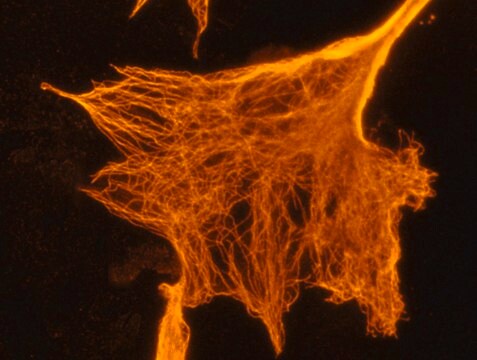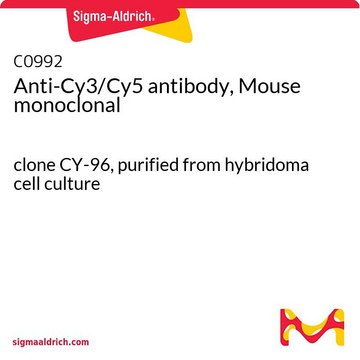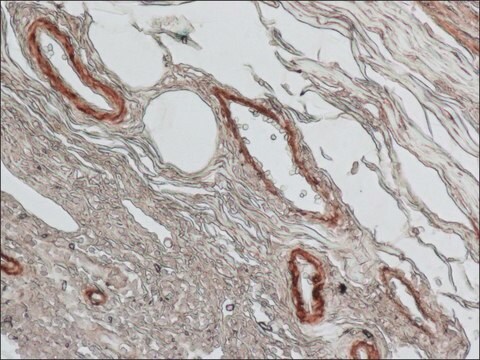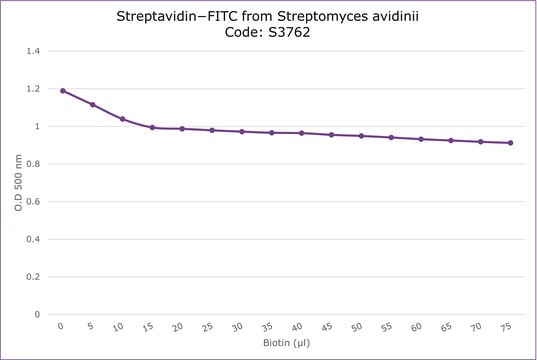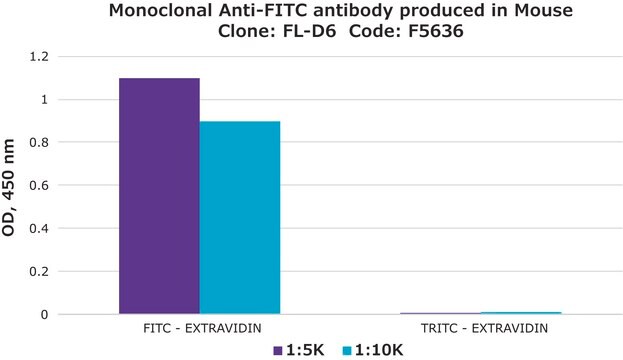추천 제품
생물학적 소스
mouse
Quality Level
결합
unconjugated
항체 형태
purified immunoglobulin
항체 생산 유형
primary antibodies
클론
CY5-15, monoclonal
형태
buffered aqueous solution
포장
antibody small pack of 25 μL
농도
~1.5 mg/mL
기술
direct ELISA: suitable
dot blot: 1-2 μg/mL using cell protein extracts labeled with Cy5
immunocytochemistry: suitable
immunoprecipitation (IP): suitable
microarray: suitable
동형
IgG1
배송 상태
dry ice
저장 온도
−20°C
타겟 번역 후 변형
unmodified
일반 설명
CyDyes are a family of fluorophores that can be used for labeling proteins, peptides, DNA, RNA, and other biomolecules. These dyes are small, pH insensitive (between pH 3 and pH 10), and soluble in aqueous solution and have tolerance to DMSO. They are more photo-stable than fluorescein, have high molar extinction coefficients, and favorable quantum yields. Due to their physical and chemical properties, they are used (mainly Cy3 and Cy5) in many different biological assays such as: DNA microarrays, protein microarrays, two-dimensional protein analysis (2D gels), fluorescence resonance energy transfer (FRET), and immunocytochemistry.
Mouse monoclonal clone CY5-15 anti-Cy5 antibody recognizes Cy5 and AlexaFluor647 labeled proteins, but not Cy3 labeled proteins.
특이성
Monoclonal Anti-Cy5 recognizes Cy5 and AlexaFluor647 labeled proteins, but not Cy3 labeled proteins.
The antibody recognizes Cy5 and AlexaFluor 647 labeled proteins, but not Cy3 labeled proteins.
면역원
mixture of proteins labeled with Cy5.
애플리케이션
Anti-Cy5 antibody, Mouse monoclonal has been used in immunofluorescence assays and western blotting.
Mouse monoclonal clone CY5-15 anti-Cy5 antibody is used to tag CyDye 5 for detection and quantitation and signal applification by or within immunocytochemical and immunohistochemical (IHC) techniques such as ELISA, immunoprecipitation, immunocytochemistry, dot blot assay, and protein microarrays. Anti-Cy5 antibody is an important tool for Cy5 signal amplification in assays where biomolecules are labeled with Cy5.
물리적 형태
Solution in 0.01 M phosphate buffered saline, pH 7.4, containing 15 mM sodium azide.
면책조항
Unless otherwise stated in our catalog or other company documentation accompanying the product(s), our products are intended for research use only and are not to be used for any other purpose, which includes but is not limited to, unauthorized commercial uses, in vitro diagnostic uses, ex vivo or in vivo therapeutic uses or any type of consumption or application to humans or animals.
적합한 제품을 찾을 수 없으신가요?
당사의 제품 선택기 도구.을(를) 시도해 보세요.
Storage Class Code
12 - Non Combustible Liquids
WGK
WGK 1
Flash Point (°F)
Not applicable
Flash Point (°C)
Not applicable
개인 보호 장비
Eyeshields, Gloves, multi-purpose combination respirator cartridge (US)
시험 성적서(COA)
제품의 로트/배치 번호를 입력하여 시험 성적서(COA)을 검색하십시오. 로트 및 배치 번호는 제품 라벨에 있는 ‘로트’ 또는 ‘배치’라는 용어 뒤에서 찾을 수 있습니다.
Dissecting the role of COPI complexes in influenza virus infection
Sun E, et al.
Journal of Virology, 87(5), 2673-2685 (2013)
Eileen Sun et al.
Journal of virology, 87(5), 2673-2685 (2012-12-21)
As an obligate pathogen, influenza virus requires host cell factors and compartments to mediate productive infection and to produce infectious progeny virus. Recently, several small interfering RNA (siRNA) knockdown screens revealed influenza virus host dependency proteins, all of which identified
Jiang He et al.
PLoS pathogens, 9(10), e1003701-e1003701 (2013-10-17)
As an obligatory pathogen, influenza virus co-opts host cell machinery to harbor infection and to produce progeny viruses. In order to characterize the virus-host cell interactions, several genome-wide siRNA screens and proteomic analyses have been performed recently to identify host
Masaaki Kuwajima et al.
PloS one, 15(1), e0226797-e0226797 (2020-01-16)
Analysis of neuronal compartments has revealed many state-dependent changes in geometry but establishing synapse-specific mechanisms at the nanoscale has proven elusive. We co-expressed channelrhodopsin2-GFP and mAPEX2 in a subset of hippocampal CA3 neurons and used trains of light to induce
자사의 과학자팀은 생명 과학, 재료 과학, 화학 합성, 크로마토그래피, 분석 및 기타 많은 영역을 포함한 모든 과학 분야에 경험이 있습니다..
고객지원팀으로 연락바랍니다.